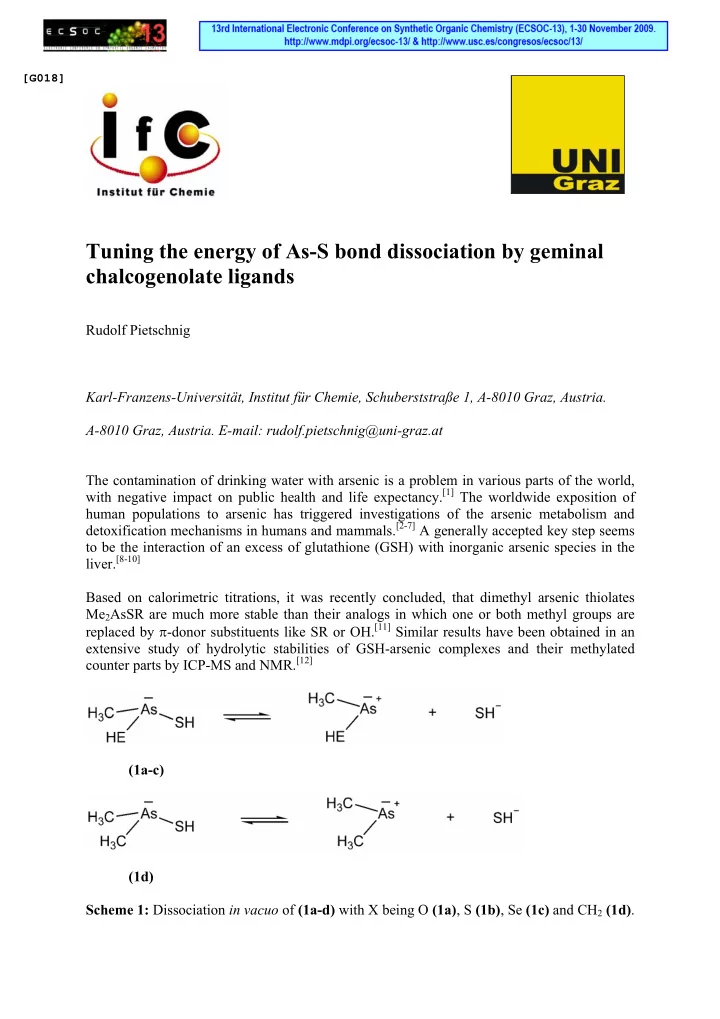

[G018] Tuning the energy of As-S bond dissociation by geminal chalcogenolate ligands Rudolf Pietschnig Karl-Franzens-Universität, Institut für Chemie, Schuberststraße 1, A-8010 Graz, Austria. A-8010 Graz, Austria. E-mail: rudolf.pietschnig@uni-graz.at The contamination of drinking water with arsenic is a problem in various parts of the world, with negative impact on public health and life expectancy. [1] The worldwide exposition of human populations to arsenic has triggered investigations of the arsenic metabolism and detoxification mechanisms in humans and mammals. [2-7] A generally accepted key step seems to be the interaction of an excess of glutathione (GSH) with inorganic arsenic species in the liver. [8-10] Based on calorimetric titrations, it was recently concluded, that dimethyl arsenic thiolates Me 2 AsSR are much more stable than their analogs in which one or both methyl groups are replaced by π -donor substituents like SR or OH. [11] Similar results have been obtained in an extensive study of hydrolytic stabilities of GSH-arsenic complexes and their methylated counter parts by ICP-MS and NMR. [12] (1a-c) (1d) Scheme 1: Dissociation in vacuo of (1a-d) with X being O (1a) , S (1b) , Se (1c) and CH 2 (1d) .
In order to find reasons why the dimethyl arsenic complexes are significantly more stable than their mono- or non methylated counterparts, we performed quantum chemical calculations on model compounds Me(XH)As-SH (1) with X being O (1a) , S (1b) and Se (1c) in comparison to the dimethyl compound (1d) (X = CH 2 ). The strength of the As-SH bond was assessed by computing its heterolytic dissociation energy according to scheme 1. The computations were performed on DFT level using a triple- ζ basis set which had proven to be sufficient in related cases. [13] The ∆ H and ∆ G values for the dissociation of complexes 1a – d are summarized in Table 1. As evident from the data, the chalcogen substituted compounds 1a – c show throughout lower dissociation energies than 1d . This can be explained with π -donation of the respective chalcogen atom into σ *-states associated with the As-S bond (negative hyperconjugation). [14- 16] Similar interactions may tune the bond character from covalent to dative for donor adducts of enium ions of P, As and Se. [13] Table 1: Calculated vacuum dissociation energies (B3LYP//6-311g(d)) for 1a-d . ∆ H 0 ∆ G 298 E code point group [kcal/mol] [kcal/mol] O 1a 181.2 169.3 C 1 S 1b 176.9 165.3 C 1 Se 1c 173.3 161.6 C 1 CH 2 1d 191.7 178.4 C S Interestingly, the largest effect is not observed for the O substituted derivative 1a although the hydroxy group generally would be considered the best π -donor in this series. The lowest dissociation energy is actually observed for the selenium substituted derivative 1c . This may be attributed to the fact that its donor orbitals allow a better spatial match with the acceptor orbitals located at arsenic, which in part reflects a favored soft-soft interaction according to the HSAB concept. [17, 18] Our results show, that S and Se substituted As cations form weaker SH (and consequently GSH) complexes and are therefore more reactive. By contrast dimethyl arsenic cations form significantly stronger SH (and consequently GSH) complexes, which makes them less reactive and might be an additional reason for the accumulation of their derivatives in the human metabolism. As a limitation of our study, it needs to be pointed out that the data refer to solvent free conditions in the gas phase. The presence of a dipolar solvent can be expected to stabilize the heterolytic bond cleavage to charged ions, which means in turn that the dissociation energies will be much lower for real systems than the values obtained by us. However, the hydration energies can be expected to be quite similar for the species 1a – d and should therefore not affect the principal outcome of our results. References [1] M. F. Hughes, Toxicol. Lett. 2002 , 133 , 1-16. [2] C. A. Loffredo, H. V. Aposhian, M. E. Cebrian, H. Yamauchi, E. K. Silbergeld, Environ. Res. 2003 , 92 , 85-91. [3] H. V. Aposhian, Annu. Rev. Pharmacol. Toxicol. 1997 , 37 , 397-419.
[4] M. Styblo, L. M. Del Razo, E. L. LeCluyse, G. A. Hamilton, C. Q. Wang, W. R. Cullen, D. J. Thomas, Chem. Res. Toxicol. 1999 , 12 , 560-565. [5] M. Styblo, L. M. Del Razo, L. Vega, D. R. Germolec, E. L. LeCluyse, G. A. Hamilton, W. Reed, C. Wang, W. R. Cullen, D. J. Thomas, Arch. Toxicol. 2000 , 74 , 289-299. [6] J. S. Petrick, F. Ayala-Fierro, W. R. Cullen, D. E. Carter, H. V. Aposhian, Toxicol. Appl. Pharmacol. 2000 , 163 , 203-207. [7] J. S. Petrick, B. Jagadish, E. A. Mash, H. V. Aposhian, Chem. Res. Toxicol. 2001 , 14 , 651-656. [8] N. Scott, K. M. Hatlelid, N. E. MacKenzie, D. E. Carter, Chem. Res. Toxicol. 1993 , 6 , 102-106. [9] M. Delnomdedieu, M. M. Basti, J. D. Otvos, D. J. Thomas, Chem. Res. Toxicol. 1993 , 6 , 598-602. [10] M. Delnomdedieu, M. M. Basti, J. D. Otvos, D. J. Thomas, Chem.- Biol. Interact. 1994 , 90 , 139-155. [11] A. M. Spuches, H. G. Kruszyna, A. M. Rich, D. E. Wilcox, Inorg. Chem. 2005 , 44 , 2964-2972. [12] A. Rumpler, Ph.-D. Thesis, Karl Franzens University Graz, 2009 . [13] R. Pietschnig, J. Organomet. Chem. 2007 , 692 , 3363–3369. [14] A. E. Reed, P. v. R. Schleyer, J. Am. Chem. Soc. 1990 , 112 , 1434-45. [15] P. v. R. Schleyer, A. J. Kos, Tetrahedron 1983 , 39 , 1141-50. [16] M. Bender, E. Niecke, M. Nieger, R. Pietschnig, Eur. J. Inorg. Chem 2006 , 380-4. [17] R. G. Pearson, J. Am. Chem. Soc. 1963 , 85 , 3533-3539. [18] R. G. Pearson, Inorg. Chim. Acta 1995 , 240 , 93-8.
Recommend
More recommend